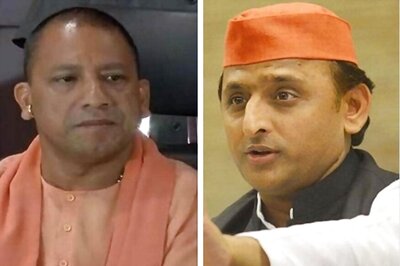
views
Their target, the softest one possible; the site of violence, some remotest corners amid vast agricultural tracts from where they can easily beat a hasty retreat; and their very modus operandi stand to bear out three very easy conclusions.
That what is left of ULFA today is just a bunch of goons, who have no ideology whatsoever and who are all amateur elements seeking their glory in blood in the name of a so-called revolution under the active patronage and tutelage of their leaders sitting in their safe havens in some foreign soil.
That ULFA is today a spent force with its old rank and file either perishing in the process of a long-drawn insurgency or retiring to quiet, anonymous family life either as small-time businessmen or contractors or simple agriculturists. The outfit is facing such a huge dearth of cadres in its ranks today that it has been forced to hire Bangladeshi boys and explore greener pastures like North Bengal to raise sister wings (like the KLF) and carry on with its bloody tirade.
That ULFA is in utter desperation to achieve a breakthrough before it runs out of manpower and firepower. Its operational territory is getting smaller and smaller, its ranks shrinking to an all-time low and even its battlefront army is today a sorry figure of untrained, ham-fisted rebels who have had little training as the training facilities of the outfit have become badly limited.
Still they fight on. Every time they seem to have gone into oblivion, the outfit strikes back. And ever since its first attack against some Hindi-speaking people created a massive hue and cry across the nation in 2001 thanks to a backlash by the Biharis against the Northeasterners as a whole, the outfit has time and again targeted them in order to be in news and whenever it needed to play the hard ball with Delhi.
New Delhi's "no-bowing-to-pressure" stand vis-Ã -vis this rogue bunch is very much justified, considering that it has been playing a very critical carrot-and-stick game in these insurgency-infested areas. But then the Centre's approach could also be a very risky one, given the fact that it is now dealing with an outfit, which is fast degenerating into a blood-thirsty and amateur militant group, which is thoroughly criminal, shorn of any ideology and manned by very young, misguided youths.
It is simply not possible to guard each and every square inch of the state as the state government pledges to do now. There are Hindi-speaking people all over Assam. It is the same Hindi-speaking people who, in a way, have shaped the modern Assam. The huge tea labourer force that has sustained the century-old Assam tea industry, incidentally, all hailed from the Hindi belt. Today, they form 10 per cent of the work force in the state.
The brick kiln industry, which has borne the brunt of ULFA violence, is entirely dependent on seasonal Bihari labourers. Post-2001, after the first wave of ULFA violence against Hindi speakers, the brick kiln industry witnessed a near-shutdown due to dearth of labourers and the ones that actually functioned were run by illegal Bangladeshi migrants.
This is not even half the story. In fact, it was the Bihari Nonias who cut jungles and built roads and bridges to make a living space in these forested belt once. Now, remind these folks that you don't dirty the hands that feed you; they will answer that with more bullets.
That's exactly why one would expect New Delhi to walk the tightrope in dealing with the crisis. The current trend of making these innocent labourers pawns of a political bargain holds dangerous portent for both the state and the North India as a whole. For, the very idea of targeting Hindi-speakers to draw Delhi's attention could become a dangerous trend in a region, where militancy has almost become a cottage industry.
Probably, Delhi needs to play a game of wit here. Months back it called a truce with the outfit and the rebels utilised all this while to re-energize itself. When the Centre realised this, it sent in more forces to tame them. But experiences show little success for such hard-hitting approaches.
The problem is, tough military measures are always bound to create unrest in the civilian space and Assamese people and media are pretty vocal against it, which in turn creates a fertile ground for the militant outfits to exploit the huge pool of unemployed youth.
The other dimension to the problem is that it's also the Hindi-speaking business community who are sustaining the ULFA and other militant outfits in the region by paying regular ransom money to buy safety guarantees. That precisely explains why the outfit picks and chooses its targets even among the Hindi-speakers. Government assurances are not enough to stem this undercurrent of extortion. And till money supply continues in plenty, militancy remains as alluring as anything else. That is precisely why Assam looks a bottomless pit till the powers that be hit upon that one big idea to outwit these goons. first published:January 08, 2007, 16:34 ISTlast updated:January 08, 2007, 16:34 IST
window._taboola = window._taboola || [];_taboola.push({mode: 'thumbnails-mid-article',container: 'taboola-mid-article-thumbnails',placement: 'Mid Article Thumbnails',target_type: 'mix'});
let eventFire = false;
window.addEventListener('scroll', () => {
if (window.taboolaInt && !eventFire) {
setTimeout(() => {
ga('send', 'event', 'Mid Article Thumbnails', 'PV');
ga('set', 'dimension22', "Taboola Yes");
}, 4000);
eventFire = true;
}
});
window._taboola = window._taboola || [];_taboola.push({mode: 'thumbnails-a', container: 'taboola-below-article-thumbnails', placement: 'Below Article Thumbnails', target_type: 'mix' });Latest News
How do a few hundred innocent seasonal daily wage earners stand on the way of United Liberation Front of Asom's struggle for sovereignty for Assam? The question flies on the face of the barbaric carnage that an outfit of a few hundred hoodlums has carried out in some remote corners of the north-eastern state.
Their target, the softest one possible; the site of violence, some remotest corners amid vast agricultural tracts from where they can easily beat a hasty retreat; and their very modus operandi stand to bear out three very easy conclusions.
That what is left of ULFA today is just a bunch of goons, who have no ideology whatsoever and who are all amateur elements seeking their glory in blood in the name of a so-called revolution under the active patronage and tutelage of their leaders sitting in their safe havens in some foreign soil.
That ULFA is today a spent force with its old rank and file either perishing in the process of a long-drawn insurgency or retiring to quiet, anonymous family life either as small-time businessmen or contractors or simple agriculturists. The outfit is facing such a huge dearth of cadres in its ranks today that it has been forced to hire Bangladeshi boys and explore greener pastures like North Bengal to raise sister wings (like the KLF) and carry on with its bloody tirade.
That ULFA is in utter desperation to achieve a breakthrough before it runs out of manpower and firepower. Its operational territory is getting smaller and smaller, its ranks shrinking to an all-time low and even its battlefront army is today a sorry figure of untrained, ham-fisted rebels who have had little training as the training facilities of the outfit have become badly limited.
Still they fight on. Every time they seem to have gone into oblivion, the outfit strikes back. And ever since its first attack against some Hindi-speaking people created a massive hue and cry across the nation in 2001 thanks to a backlash by the Biharis against the Northeasterners as a whole, the outfit has time and again targeted them in order to be in news and whenever it needed to play the hard ball with Delhi.
New Delhi's "no-bowing-to-pressure" stand vis-Ã -vis this rogue bunch is very much justified, considering that it has been playing a very critical carrot-and-stick game in these insurgency-infested areas. But then the Centre's approach could also be a very risky one, given the fact that it is now dealing with an outfit, which is fast degenerating into a blood-thirsty and amateur militant group, which is thoroughly criminal, shorn of any ideology and manned by very young, misguided youths.
It is simply not possible to guard each and every square inch of the state as the state government pledges to do now. There are Hindi-speaking people all over Assam. It is the same Hindi-speaking people who, in a way, have shaped the modern Assam. The huge tea labourer force that has sustained the century-old Assam tea industry, incidentally, all hailed from the Hindi belt. Today, they form 10 per cent of the work force in the state.
The brick kiln industry, which has borne the brunt of ULFA violence, is entirely dependent on seasonal Bihari labourers. Post-2001, after the first wave of ULFA violence against Hindi speakers, the brick kiln industry witnessed a near-shutdown due to dearth of labourers and the ones that actually functioned were run by illegal Bangladeshi migrants.
This is not even half the story. In fact, it was the Bihari Nonias who cut jungles and built roads and bridges to make a living space in these forested belt once. Now, remind these folks that you don't dirty the hands that feed you; they will answer that with more bullets.
That's exactly why one would expect New Delhi to walk the tightrope in dealing with the crisis. The current trend of making these innocent labourers pawns of a political bargain holds dangerous portent for both the state and the North India as a whole. For, the very idea of targeting Hindi-speakers to draw Delhi's attention could become a dangerous trend in a region, where militancy has almost become a cottage industry.
Probably, Delhi needs to play a game of wit here. Months back it called a truce with the outfit and the rebels utilised all this while to re-energize itself. When the Centre realised this, it sent in more forces to tame them. But experiences show little success for such hard-hitting approaches.
The problem is, tough military measures are always bound to create unrest in the civilian space and Assamese people and media are pretty vocal against it, which in turn creates a fertile ground for the militant outfits to exploit the huge pool of unemployed youth.
The other dimension to the problem is that it's also the Hindi-speaking business community who are sustaining the ULFA and other militant outfits in the region by paying regular ransom money to buy safety guarantees. That precisely explains why the outfit picks and chooses its targets even among the Hindi-speakers. Government assurances are not enough to stem this undercurrent of extortion. And till money supply continues in plenty, militancy remains as alluring as anything else. That is precisely why Assam looks a bottomless pit till the powers that be hit upon that one big idea to outwit these goons.


















Comments
0 comment